Allotment layout ideas
Starting your first allotment or vegetable garden is exciting but can also be a bit scary without the right guidance. Those new to gardening or those that have left their allotment stagnant for a few years, often find it hard to figure out how to use their space, plan for different seasons, and rotate their crops. But don’t worry, these challenges can be overcome with a good plan!
A well thought-out allotment design and layout is crucial for maximising crop yield, ensuring a sustainable crop rotation and making efficient use of available space. By addressing these issues at the planning stage, new gardeners can avoid common problems such as overcrowding, poor sunlight exposure, and water management issues.
In this blog, we’ll guide you through the basics of planning your gardens or allotments design and layout, providing practical tips to help you design an allotment that reflects both your inner-farmer and the unique characteristics of your plot.
Contents:
- How to plan an allotment layout
- Best allotment layout and design
- Get your allotment ‘sprouting’ into life

How to plan an allotment layout
Your allotment’s layout is more important than you might think – how you place your fruit, vegetables and plants can really impact how well they grow (it’s crucial to get this right from the start). Focusing on key elements in your layout design is what helps your plot thrive, which is why once the basics are covered, you can be more flexible in how you design the rest of your patch.
- Sunlight and orientation
- Water access
- Pathways and accessibility
- Companion plants
- Crop rotation
Sunlight and orientation
The amount and intensity of sunlight your plants receive directly affects their growth and how well the end-of-season yield will be. Most vegetables and fruits require at least 6-8 hours of direct sunlight daily to develop properly, however, too much sun can harm sensitive plants, making shade equally important for species that prefer cooler, less intense light.
For those lucky enough to pick their own allotment location, aim for a spot that enjoys lots of sun – sunlight is key to a thriving garden, so make it a top priority in your choice!
Water access
Watering your plants is a constant task on an allotment especially in the summer months – if available, choose a plot near a water source or water butts to cut down on effort (you’ll thank us later!).
Although rotating vegetable crops means their distance from water will vary, perennials with deep roots, such as fruit trees, can thrive even when planted further away, needing less water. On the other hand, soft fruits with shallow roots, like strawberries and raspberries, benefit from being closer to water, reducing the effort needed to keep them hydrated.
Pathways and accessibility
When mapping out your allotment’s design and layout, it’s important to plan the space efficiently. Including grass paths in your drawings helps to avoid the risk of compacting the soil in your beds by walking on them.
A central pathway, with raised beds on each side, is ideal for straightforward crop access and efficient use of space on smaller patches. On larger plots, two opposing paths could facilitate access and diversify planting strategies further down the line. When laying your path, make sure that the foundation is secure by using a mix of sand and gravel. Once this is done, you can then finish off with turf or wood chips, depending on which you find most appealing.
Companion plants
In gardening, and especially in allotment sites, companion planting involves placing different plants near each other for mutual gain. This method is especially useful in allotments, offering advantages like pest reduction and higher crop yields (essentially, certain plants can improve each other’s growth).
Crop rotation
Planning your allotment layout with year crop rotation in mind is essential – while some crops are annual, plants like asparagus can remain productive for up to 20 years, and fruit trees for even longer, so consider carefully if these permanent fixtures are what you want.
For annuals, adopting a crop rotation system, typically over two to three years, moving from brassicas to root vegetables, then to other veggies, helps keep your soil healthy and your produce varied. With three or more beds, you can easily start this rotation, ensuring each bed hosts a different vegetable type each year, sustaining soil health and providing a wide range of produce.
Best allotment layout and design
The most efficient layout for allotments includes a sizeable central pathway that allows for easy movement and wheelbarrow access. Adjacent to this path, raised beds should be constructed, running horizontally to ensure easy planting and maintenance. To ensure every part of the garden is accessible, leave sufficient space for pathways around the exterior of the plot, so that gardeners can reach each raised bed easily without disturbing the soil of adjacent beds.
For those with larger plots, incorporating more pathways and raised beds is recommended.

Get your allotment ‘sprouting’ into life
Planning an allotment design and layout for beginners is an exciting and rewarding journey into sustainable living and gardening.
By focusing on the tips mentioned in this guide, you can create a productive and beautiful gardening patch. Remember, the key to success is starting small, learning as you go, and enjoying the process (we all started somewhere!). Speaking to some of your new fellow gardeners for some hints and tricks will also help, as the soil type in your area can also influence what you decide grow.
Here at Alsoils, we provide a range of landscaping products and services that will help improve your new allotment. Whether it’s a bulk bag of fruit and vegetable topsoil, mushroom compost, organic manure or soil conditioner, we have the capabilities to help with your new passion project!





